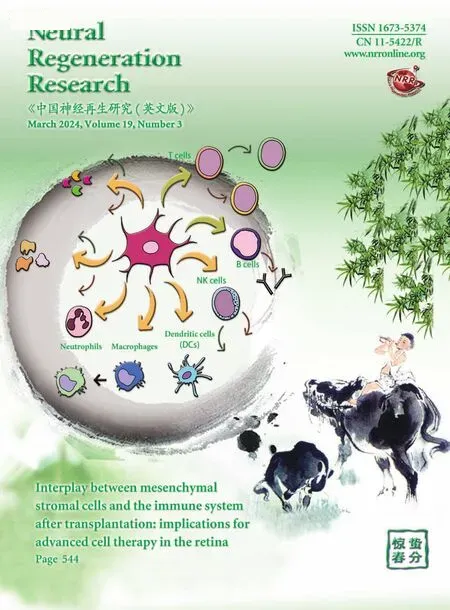Artificial intelligence-assisted repair of peripheral nerve injury: a new research hotspot and associated challenges
2024-02-18YangGuoLiyingSunWenyaoZhongNanZhangZongxuanZhaoWenTian
Yang Guo,Liying Sun,Wenyao Zhong,Nan Zhang,Zongxuan Zhao,Wen Tian
Abstract Artificial intelligence can be indirectly applied to the repair of peripheral nerve injury.Specifically,it can be used to analyze and process data regarding peripheral nerve injury and repair,while study findings on peripheral nerve injury and repair can provide valuable data to enrich artificial intelligence algorithms.To investigate advances in the use of artificial intelligence in the diagnosis,rehabilitation,and scientific examination of peripheral nerve injury,we used CiteSpace and VOSviewer software to analyze the relevant literature included in the Web of Science from 1994–2023.We identified the following research hotspots in peripheral nerve injury and repair: (1) diagnosis,classification,and prognostic assessment of peripheral nerve injury using neuroimaging and artificial intelligence techniques,such as corneal confocal microscopy and coherent anti-Stokes Raman spectroscopy;(2)motion control and rehabilitation following peripheral nerve injury using artificial neural networks and machine learning algorithms,such as wearable devices and assisted wheelchair systems;(3) improving the accuracy and effectiveness of peripheral nerve electrical stimulation therapy using artificial intelligence techniques combined with deep learning,such as implantable peripheral nerve interfaces;(4) the application of artificial intelligence technology to brain-machine interfaces for disabled patients and those with reduced mobility,enabling them to control devices such as networked hand prostheses;(5) artificial intelligence robots that can replace doctors in certain procedures during surgery or rehabilitation,thereby reducing surgical risk and complications,and facilitating postoperative recovery.Although artificial intelligence has shown many benefits and potential applications in peripheral nerve injury and repair,there are some limitations to this technology,such as the consequences of missing or imbalanced data,low data accuracy and reproducibility,and ethical issues (e.g.,privacy,data security,research transparency).Future research should address the issue of data collection,as large-scale,high-quality clinical datasets are required to establish effective artificial intelligence models.Multimodal data processing is also necessary,along with interdisciplinary collaboration,medical-industrial integration,and multicenter,large-sample clinical studies.
Key Words: artificial intelligence;artificial prosthesis;medical-industrial integration;brain-machine interface;deep learning;machine learning;networked hand prosthesis;neural interface;neural network;neural regeneration;peripheral nerve
From the Contents
Introduction 663
Methods 663
Results 664
Discussion 668
Introduction
Artificial intelligence (AI) can be used to analyze and process data about neural regeneration (Christopher et al.,2020;Williams et al.,2020;Daeschler et al.,2022;Sun et al.,2022;Signaevsky et al.,2022).For example,AI can be used to assess the degree of neuroplasticity and the therapeutic effectiveness of neural stem cells.Research on peripheral nerve injury and repair can also provide valuable data to AI algorithms (Luu et al.,2021),which can,for example,guide the analysis of neural signals and the implementation of neural networks in robotic architectures.Thus,AI systems and research on peripheral nerve injury and repair can reinforce one another to drive medical innovations.AI,which links computer science with neurology,has already been used to assess peripheral nerve injury and repair.For instance,it has been used to develop new research methods and techniques for nerve regeneration (Romeo-Guitart et al.,2018;Luu et al.,2022).Peripheral nerve injury and repair refers to the loss and subsequent regeneration of neurons as the result of an injury or disease.AI can be used to predict the pathological manifestations of the peripheral nervous system and to explore better therapeutic approaches.
Among the various AI technologies that have been applied to peripheral nerve injury and repair,artificial neural networks are commonly used to test the connections and communication between neurons (Koh et al.,2020;Lei and Wu,2022;Zhao et al.,2022;Khaliq et al.,2023).This technique can be used to understand how neurons might regenerate,leading to the restoration of neural functions after nervous system impairment.In addition,AI can be used to identify and quantitatively assess the morphology and structure of neurons via imaging techniques (Daeschler et al.,2022).AI relies on data imaging to accurately and quantitatively assess neuronal regeneration.Furthermore,machine learning algorithms can be used to determine which genes and pathways are critical for neural regeneration (Stewart et al.,2018;Aberathne et al.,2023).Therefore,AI can be used to enhance our understanding of neural regeneration.Some studies have addressed the intelligent design of nerve guidance conduits with tubular structures made of biomaterials that can guide axonal regeneration from the injured proximal nerve to the distal stump.However,some technical issues and innovation bottlenecks remain.Moreover,AI techniques have not been widely used in clinical practice,except in peripheral nerve injury and repair (Stewart et al.,2020).
Here,we conducted a literature visualization analysis with the goal of identifying research hotspots relevant to AI applications in peripheral nerve injury and repair.
Methods
Search strategy and selection criteria
The first author searched the Web of Science (WOS) Core Collection database for literature regarding AI applications in peripheral nerve injury and repair.The literature search was performed on March 31,2023.
Search strategy
The search strategies used with the WOS Core Collection are shown inTable 1.We conducted a topic search (TS),including the text in the title,abstract,and keywords.In total,613 articles were included.

Table 1|Search strategies for literature on the application of artificial intelligence toperipheral nerve injury and repair in the Web of Science Core Collection database
Selection criteria
After reading the document titles and abstracts,documents on AI applications in peripheral nerve injury and repair were retrieved and included in this paper,with no restrictions on article style.
Data analysis software and parameter settings
Visual analysis software
(1) CiteSpace 6.2.R2 Basic software is a JAVA application,developed by Dr.Chaomei Chen from Drexel University.This software enables the visualization and analysis of trends and frontier areas in a scientific field through cooccurrence and co-citation analyses of massive datasets of literature (Chen,2004;Chen and Song,2019).
(2) VOSviewer 1.6.18 software is a tool used to generate literature co-citation networks based on web or bibliometric data,which can be used to create cooccurrence and clustering maps (Arruda et al.,2022).
Data export and processing
The WOS Core Collection database was set to contain full records with cited references exported in plain text as TXT files and imported into VOSviewer 1.6.18 software and CiteSpace 6.2.R2 Basic software.This dataset was then used to create scientific knowledge maps,which illustrate scientific knowledge processing and structural relationships,and show trends in subject knowledge domains.
Parameter settings for VOSviewer
We performed country co-occurrence analysis using VOSviewer software,with the minimum number of publications from a country set to 10 articles.This enabled us to visualize the density of research from specific countries and institutional cooperation networks,and to conduct cluster analysis regarding cooperation between countries for publications.
Parameter settings for CiteSpace
The time slicing parameter was set to inc lude articles from January 1994 to March 2023 (CiteSpace 6.2.R2 Basic software can only analyze literature published in the last 30 years),with the default of “1” year as a time zone.Burst Term was selected as the type of subject term used.Keywords and literature or journal were selected as node types for the co-occurrence analysis and co-citation analysis,respectively.
(1) We conducted a literature co-citation analysis to identify the research hotspots in our chosen scientific field (Chen et al.,2010).We created literature co-citation maps using Citespace according to the following selected parameters: an article was defined as a node,the citation frequency was set as the node size,and a connection was established when there was a co-citation relationship between documents.We then conducted a cluster analysis.Co-citation maps can be used to identify “hot” documents that have been frequently cited by other scholars.
(2) We created a journal co-citation analysis map to analyze the distribution of “hot” journals in the field.
(3) We created double-map overlays of journals to analyze the research directions of journals in the field.
(4) Co-occurrence analysis maps of keywords were generated to analyze burst terms in the field.
We used the following settings: Topn=50 for the threshold setting;Pathfinder to prune the author-institutional collaboration networks;and‘pruning the merged network’ for the keyword co-occurrence and literature co-citation analysis.
A burst detection algorithm was used to identify innovative topics,as proposed by Goldberg et al.(2002).
Main outcome measures
The integrated visual mapping and bibliometric functions of the WOS Core Collection were used to analyze the number of publications,journals,institutions,countries,keywords,and highly cited articles relevant to the research topic.
Results
Analysis of countries/regions with publications on AI applications in peripheral nerve injury and repair
The VOSviewer 1.6.18 results indicated that there were 18 countries with a minimum of 10 publications on the research topic (Figure 1).There were five clusters (#1–#5),divided by research direction (different colors marked inFigure 1).The five countries with the most publications were the USA,China,Italy,Japan,and Germany,which are the countries with the greatest research output regarding the use of AI in peripheral nerve injury and repair.
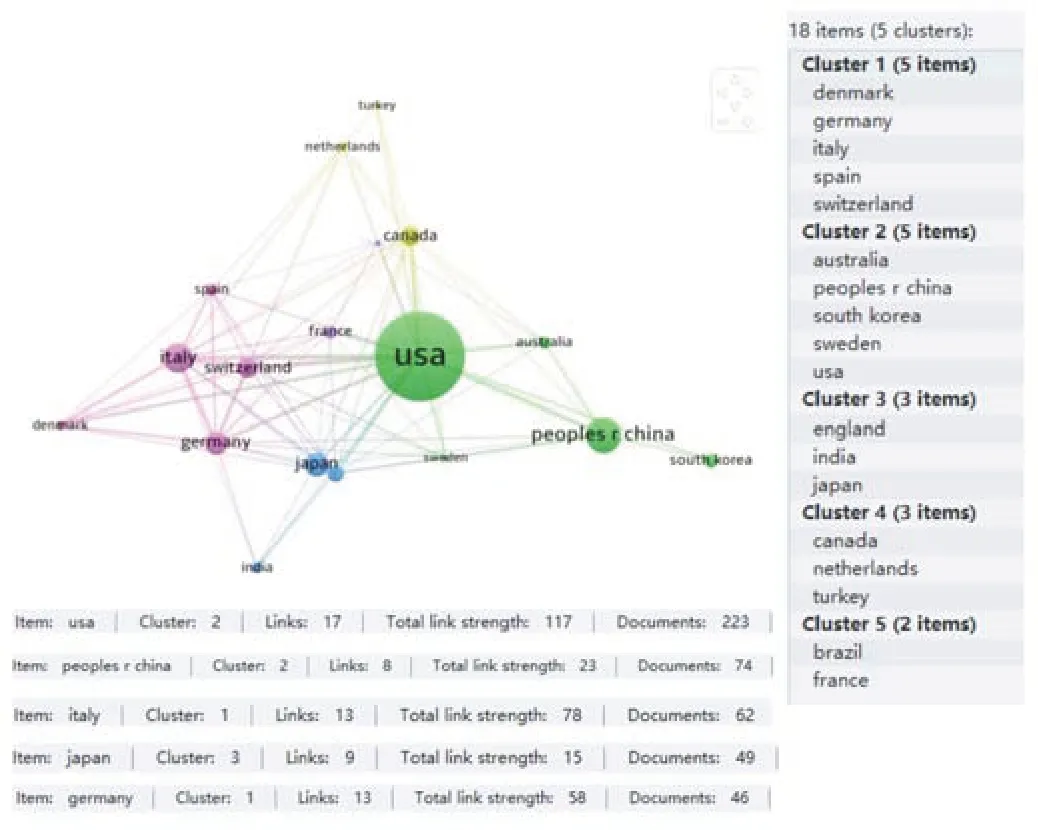
Figure 1|Country/region-based distribution of artificial intelligence research in peripheral nerve injury and repair (data from 613 papers retrieved from the Web of Science Core Collection database).
Analysis of institutions with publications on AI applications in peripheral nerve injury and repair
The CiteSpace 6.2.R2 Basic results showed that of the 613 articles,19 were published by the Federal Institutes of Technology in Lausanne,Switzerland,16 were published by Harvard University,USA,and 15 were published by Sant’Anna School of Advanced Studies,Pisa,Italy.Switzerland,USA,and Italy were the three countries with the greatest number of cited articles in this field (Table 2).

Table 2|The 10 research institutions with the greatest number of publications on the application of artificial intelligence in peripheral nerve injury and repair (data from 613 articles retrieved from the Web of Science Core Collection database)
Analysis of research hotspots and “hot” journals regarding AI applications in peripheral nerve injury and repair based on journal citations
Journal co-citation burst analysis showing the journals with a focus on relevant research hotspots
J COMP NEUROL had the strongest focus on AI applications in peripheral nerve injury and repair,and also followed relevant hotspots for the longest duration (1994–2013).Over the past 5 years (2019–2023),SCI REP-UK,NAT COMMUN,ELIFE,SENSORS-BASEL,ARXIV PREPRINT ARXIV,IEEE ACCESS,PROC CVPR IEEE,and FRONT NEUROL were the main journals with a focus on AI applications in peripheral nerve injury and repair (Figure 2).
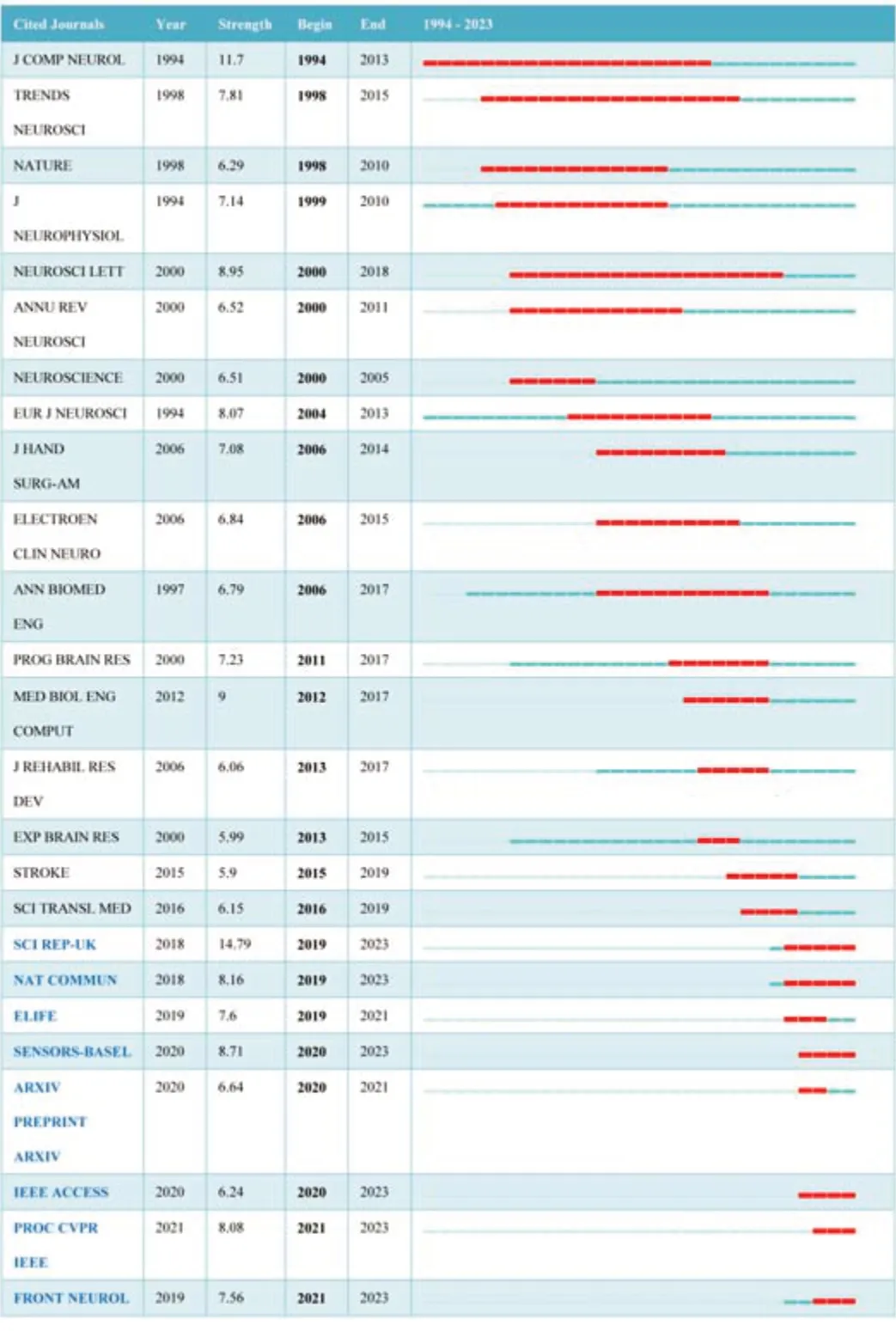
Figure 2|The 25 journals with the strongest citation bursts in terms of the applications of artificial intelligence in peripheral nerve injury and repair from 1994 to 2023 (data from 613 articles retrieved from the Web of Science Core Collection database).
Most frequently cited journals
The three journals with the most citations regarding AI applications in peripheral nerve injury and repair identified according to the 613 included articles published from 1994–2023 were NATURE,J NEUROSCI,and J NEUROPHYSIOL (Table 3).
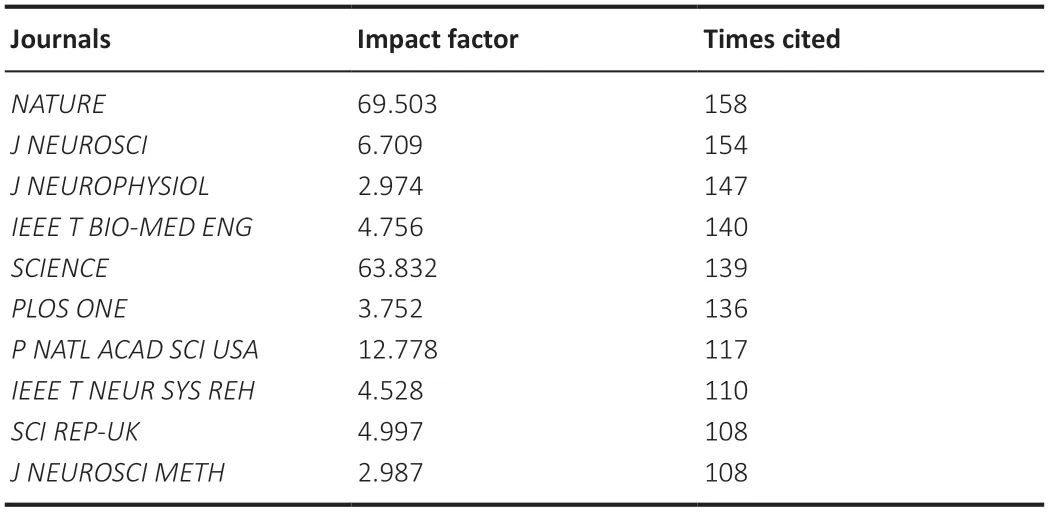
Table 3|The 10 journals with the largest number of citations regarding the application of artificial intelligence in peripheral nerve injury and repair (data from the 613 articles retrieved from the Web of Science Core Collection database)
Dual-map overlays showing the research directions of burst journals
According to the basic literature data provided by CiteSpace,the dual-map overlay data were all sourced from Journal Citation Reports (JCR) 2011.
The journal dual-map overlay results indicated that AI remained a “hot” research topic in the field of peripheral nerve injury and repair,receiving attention from NATURE,J NEUROSCI,SCIENCE,etc.,during the study period.
We used the Blondel algorithm to create dual-map overlays based on the 613 included articles,as shown inFigure 3,where the left-hand side shows the distribution of the citing journals and the right-hand side shows the distribution of the cited journals (Chen et al.,2014).
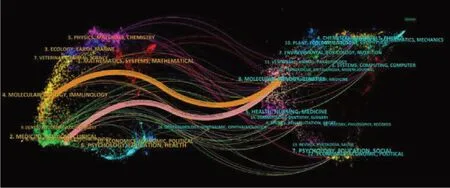
Figure 3|Dual-mapoverlays of cited/citing journals for 613 articles regarding artificial intelligence applications in peripheral nerve injury and repair from 1994–2033 (data from the Web of Science Core Collection database).
Figure 3demonstrates that the citing journals mainly focused on two aspects:the fields of neurology,kinesiology,and ophthalmology;or research about molecules,biology,and immunology.The cited journals mainly focused on the latter aspect.Neurology,kinesiology,ophthalmology,molecular biology,immunology,and genetics were more closely linked across journals,and had been “hot” frontiers of AI research in the field of peripheral nerve injury and repair (shown by the two thick curves inFigure 3).
Keyword analysis of research on AI applications in peripheral nerve injury and repair
Keyword cluster analysis
We used VOSviewer 1.6.18 software to conduct the cluster analysis of 613 articles (Figure 4),which involved four clusters:

Figure 4|Keyword clustering network diagram (data from 613 articles retrieved from the Web of Science Core Collection database).
#1 Artificial intelligence,brain-computer interfaces,deep learning;
#2 Machine learning,neural interfaces,peripheral nerve;
#3 Neural network,peripheral nervous system,spinal cord;
#4 Rehabilitation,spinal cord injury,stroke.
We identified four main research directions regarding the application of AI in the field of peripheral nerve injury and repair:
(1) Brain-computer interfaces and deep learning related technologies;
(2) Machine learning and neural interface related technologies;
(3) Neural networks related to spinal cord injury;
(4) Stroke and spinal cord injury rehabilitation.
Keyword burst analysis
The keyword burst analysis of 613 articles indicated that the research in this field could be mainly divided into two phases: (1) there was a focus on neurostimulation from 2012–2019;(2) deep learning,artificial intelligence,and machine learning were burst words from 2019 until the present (Figure 5).

Figure 5|Keyword burst analysis of the application of artificial intelligence in the field of peripheral nerve injury and repair (data from 613 articles retrieved from the Web of Science Core Collection database).
Literature co-citation cluster analysis regarding the application of artificial intelligence to peripheral nerve injury and repair
We obtained a total of 117 clusters,and the literature co-citation network included the largest seven clusters.These seven most representative clusters are detailed inTable 4andFigure 6.

Figure 6| Literature co-citation cluster map regarding the application of artificial intelligence in peripheral nerve injury and repair (data from 613 articles retrieved from the Web of Science Core Collection database).
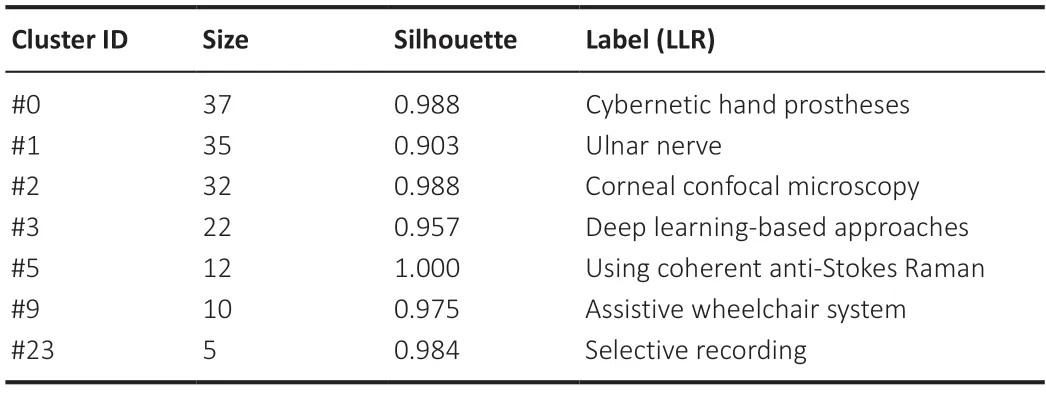
Table 4|Clusters of co-cited articles regarding the application of artificial intelligence in peripheral nerve injury and repair (data from 613 articles retrieved from the Web of Science Core Collection database)
Cluster #0: Cybernetic hand prostheses.The main citing article of the cluster is Micera et al.(2008).In recent years,significant progress has been made in the development of highly sensory-neural network prostheses designed to restore sensory-motor functions in patients who have lost these functions owing to traumatic events (amputation).In these cases,one of the main goals is to establish a bidirectional connection between an artificial device(e.g.,a robotic hand,arm,or leg) and the nervous system.Several humanmachine interfaces have been used.Among them,the interface to the peripheral nervous system,especially to the longitudinal silent intraelectrode,is a promising solution.Micera et al.(2008) described the potential and limitations of such interfaces to control robotic devices.
Cluster #1: The ulnar nerve.The main citing article in the cluster was Vu et al.(2020).The loss of upper extremity motor function can have a devastating impact on quality of life.To restore upper extremity function,researchers and clinicians have developed interfaces that interact directly with the human motor system.Vu et al.(2020) reviewed the details of existing peripheral nerve(ulnar nerve) interfaces and brain-computer interfaces used for upper extremity control over the past 30 years,and highlighted the challenges that remain in translating this technology to clinical practice.In this review,peripheral nerve interfaces and brain-machine interfaces were confirmed to have many similar characteristics,and they can be developed simultaneously.Decoding neural information from both interfaces may lead to new physiological models with the potential to fully restore upper extremity motor function in patients.
Cluster #2: Corneal confocal microscopy.In the past 20 years,corneal confocal microscopy has been increasingly used to image small basal nerve fibers in various peripheral neuropathies and central neurodegenerative diseases.Corneal confocal microscopy has been used to identify subclinical nerve damage and to predict the development of diabetic peripheral neuropathy.Large datasets of 2D corneal nerve images can facilitate the application of AIbased deep learning algorithms.Deep learning algorithms are comparable to manual quantification,but superior to automated quantification in terms of corneal nerve morphology.Recently,end-to-end classification with a 3-class AI model,designed by Alam et al.(2022),was shown to have high sensitivity and specificity in distinguishing healthy volunteers from those with or without peripheral neuropathy.The researchers concluded that AI could be applied to the classification of peripheral neuropathy from neurodegenerative diseases in the central nervous system.These findings indicate that AI has significant potential in improving the diagnostic and prognostic value of corneal confocal microscopy in the treatment of neurodegenerative diseases in the peripheral and central nervous systems.
Cluster #3: Deep learning-based approaches.The main citing article in the cluster was Farina et al.(2021).Robotic limbs can deliver information about the environment with greater precision than biological limbs.However,their actual performance is limited by the current technologies used to connect robotic devices to the body,enabling bidirectional transmission of motor and sensory information between the prosthesis and the user.Farina et al.(2021) considered the direct skeletal attachment of bionic devices via osseointegration,the amplification of neural signals by targeted muscle innervation,the improvement of prosthesis control via implanted muscle sensors and advanced algorithms,and the provision of sensory feedback via electrodes implanted in peripheral nerves,and reported that all of these approaches could be beneficial in creating a new generation of high-performance bionic limbs.These technologies have been preliminarily tested in humans,and mechanical redesigns and appropriate rehabilitation training is expected to contribute to the wider use of bionic limbs in clinical practice.
Cluster #5: Using coherent anti-Stokes Raman spectroscopy.The main citing article in the cluster was Kim et al.(2019).The researchers proposed a new approach to glaucoma diagnosis and localization that relies solely on fundus images,which are analyzed via cutting-edge deep learning techniques.Medinoid was presented as a publicly available prototype of a web application for the computer-aided diagnosis and localization of glaucoma,which finally integrates the most effective predictive model.
Cluster #9: Assistive wheelchair systems.The main citing article in the cluster was Li et al.(2013).With brain-computer interface technology,people with disabilities do not need to use traditional pathways,such as peripheral nerves and muscles,to communicate with the outside environment.Instead,they can communicate using brain activity.Li et al.(2013) designed an electroencephalography-based wheelchair that can be guided by the user’s thoughts without the involvement of other factors.This wheelchair was both accurate and had good performance in operational tests in an actual environment.This technology has great potential for daily applications in people with disabilities.
Cluster #23: Selective recording.The main citing article in the cluster was Sammut et al.(2020).Peripheral nerve interfaces allow researchers to extract motor,sensory,and autonomic information from the nervous system and use it as a control signal in neural prostheses and neuromodulatory systems.Recent studies have attempted to elevate the recording selectivity of peripheral nerve interfaces,including the use of spatiotemporal patterns from multi-contact neural cuff electrodes as input to convolutional neural networks.Before being applied to humans,this methodology must be evaluated in terms of its performance during chronic implantation.Sammut et al.(2020) investigated the performance of a convolutional neural networkbased selective recording approach in the presence of encapsulation tissue,which is a common immune response to the implantation of neural interfaces.This factor was simulated via an anatomically accurate computational model of rat sciatic nerves and nerve cuff electrodes.Their study found that a periodic calibration approach may be effective in compensating for alterations in signal recording over time.
In-depth analysis of the most frequently cited literature on the application of artificial intelligence in peripheral nerve injury and repair
Hotspot analysis of the most influential co-cited literature
The cited literature for each node in each cluster was ranked according to cocitation counts,and the 10 articles with the most co-citations are shown inTable 5.Raspopovic et al.(2014) from the BioRobotics Institute at the Scuola Superiore in Sant’Anna,Italy,was the most co-cited article (Citation Counts:20),and thus the leading “hot” study.This was followed by Davis et al.(2016)from the Department of Bioengineering,University of Utah,USA (Citation Counts 18),and Navarro et al.(2005) from the Department of Cell Biology,Physiology and Immunology,at the Universitat Autònoma de Barcelona,Spain(Citation Counts: 15).These three authors were the most influential scholars in the field of AI applications to peripheral nerve injury and repair.

Table 5|The 10 most co-cited articles on the application of artificial intelligence in peripheral nerve injury and repair (sorted by co-citation counts) (data from 613 articles retrieved from the Web of Science Core Collection database)
Among the 10 most co-cited publications,there were three publications in Cluster #0,which were focused on AI control+electrode implantation +artificial prosthesis (upper limb)+information feedback+peripheral nerve interface: Navarro et al.(2005),Dhillon et al.(2004,2005).There were three publications in Cluster #1,focused on AI control+electrode stimulation +artificial prosthesis (upper limbs)+information feedback: Raspopovic et al.(2014),Tan et al.(2014),and Rossini et al.(2010).There was one publication in Cluster #2,which was focused on AI+path localization: Ronneberger et al.(2015);and two publications in Cluster #3: Davis et al.(2016),which focused on AI control+electrode implantation in peripheral nerves+information feedback,and Vu et al.(2018),which focused on AI control+artificial prosthesis (hands).There was one publication in Cluster #5: Kingma and Ba(2014),which focused on AI algorithms.
These were the 10 most influential publications on AI applications to peripheral nerve injury and repair.
Cluster analysis of hotspots in the co-cited literature over the last 5 years
Figure 7shows a cluster map of literature co-citations for research hotspots in terms of the application of AI to peripheral nerve injury and repair from 2018 to 2022.
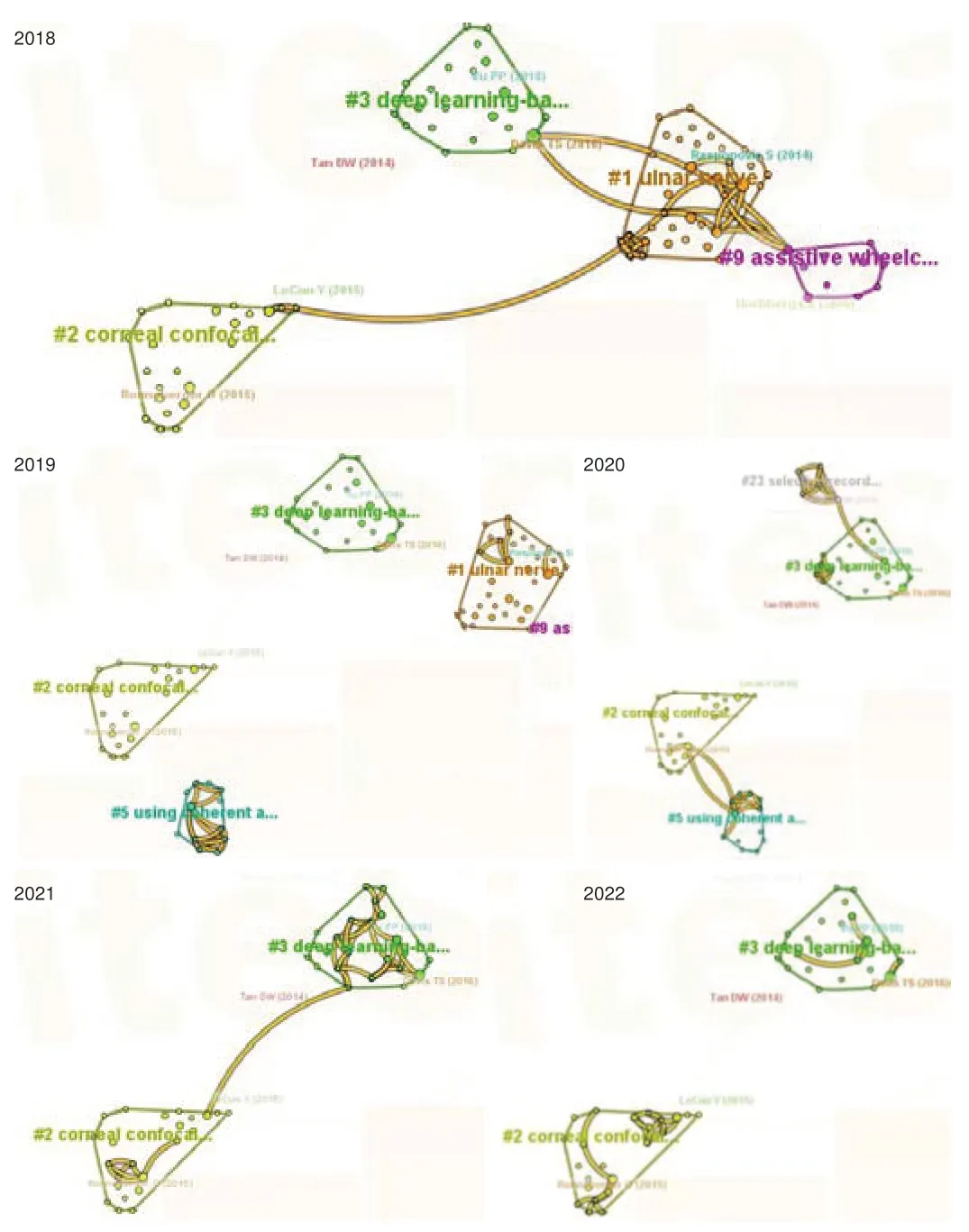
Figure 7| Hotspot cluster analysis of literature co-citations regarding the application of artificial intelligence in peripheral nerve injury and repair from 2018–2022 (data from the Web of Science Core Collection database).
The research hotspots in 2018 could be clustered as follows: #1 the ulnar nerve,#2 corneal confocal microscopy,#3 deep learning-based approaches,and #9 assistive wheelchair systems.Clusters #3,#1,and #9 are closely related.The main research directions can be summarized as the application of deep learning in the repair of peripheral nerve injury and the rehabilitation of peripheral nerve injury,promoted via assistive wheelchair systems.The cocited articles with high popularity in 2018 were Tan et al.(2014) and Davis et al.(2016).
The research hotspots in 2019 could be clustered as follows: #1 the ulnar nerve,and #5 the use of coherent anti-Stokes Raman spectroscopy.These hotspots are in different fields and were not correlated,indicating that the research hotspots in 2019 were not very prominent.
The research hotspots in 2020 could be clustered as follows: #2 corneal confocal microscopy,#3 deep learning-based approaches,#5 the use of coherent anti-Stokes Raman spectroscopy,and #23 selective recording,with close relationships between #2 and #5,and between #3 and #23.The research hotspots in 2020–2021 could be clustered as follows: #2 corneal confocal microscopy,and #3 deep learning-based approaches.The two clusters were close but not very close.Collaboration was common in each cluster.The research hotspots were basically the same as in 2020,indicating the presence of similar research hotspots from 2020 to 2023.
The major research directions from 2020 to 2022 could be summarized as the application of AI-based imaging tools in the diagnosis of peripheral nerve diseases and the signal control of peripheral nerve interfaces based on deep learning.Ronneberger et al.(2015) and Vu et al.(2018,2020) were the cocited articles with highest popularity in 2020–2022.
Hotspot-based analysis of highly cited articles in the Web of Science Core Collection database
The definition of a ‘highly cited’ article was as follows: By November/December 2022,based on the high citation threshold of the corresponding field and publication year,the citation frequency of the article had entered the top 1% in the academic field of engineering,according to data from the Essential Science Indicators database.Two of the 613 included articles could be classified as highly cited according to the WOS database.Ijspeert et al.(2014) summarized the use of biological robots as physical models for hypothesis testing in the fields of hydrodynamics,biomechanics,neuroscience,and prosthetics,and proposed that their use may facilitate the design of prosthetic devices that more closely follow the principles of human movement compared with previous options.Lee et al.(2019) introduced asynchronously coded electronic skin,which is a neural simulation system that can simultaneously transmit heat-tactile information while maintaining extremely low read latency,even though its array size exceeds 10,000 sensors.The asynchronously coded electronic skin platform is expected to integrate a wide range of skin-like sensors for AI-enhanced autonomous robots,neuroprostheses,and neuromorphic computational metal implants for flexible object manipulation and somaesthesia.
Discussion
Interpretation of visual analysis results
The USA and countries in Europe occupy a leading position in the application of AI to peripheral nerve injury and repair,and the USA is unequivocally dominant in this field.The Ecole Polytechnique Federale de Lausanne in Switzerland,Harvard University in the USA,and Scuola Superiore Sant’Anna in Italy are the three institutions with the largest output of AI research in the field of peripheral nerve injury and repair.NATURE,J NEUROSCI,and J NEUROPHYSIOL are the most authoritative and influential journals with a focus on AI research in the field of peripheral nerve injury and repair.The research directions in this field are mainly focused on neurology,kinematics,ophthalmology,molecular,biology,immunology,and genetics,which are related.
The keyword cluster analysis revealed four major research directions in the application of AI to the field of peripheral nerve injury and repair: (1) braincomputer interface-and deep learning-related technologies;(2) machine learning-and neural interface-related technologies;(3) neural networks related to spinal cord injury;(4) stroke and spinal cord injury rehabilitation.The keyword burst analysis showed that deep learning,AI,and machine learning have become burst terms over the last 5 years.
To further examine the research hotspots in this field,we conducted a cluster analysis of the literature co-citations among the included articles.We obtained seven clusters: cybernetic hand prostheses,the ulnar nerve,corneal confocal microscopy,deep learning-based approaches,the use of coherent anti-Stokes Raman spectroscopy,and assistive wheelchair systems.The literature in these clusters mainly focused on AI control,electrode implantation,artificial prosthesis,information feedback,and peripheral neural interfaces.Further analysis showed that the AI research in the field of peripheral nerve injury and repair mainly focused on AI control,peripheral nerve electrode stimulation,artificial prosthesis (upper limb) control,and information feedback.The ultimate purpose of the research was to use AI to control artificial prostheses,enabling patients with amputation and limb injury to recover limb function more quickly,and to create prosthetic limbs with better control for movement rehabilitation.
We next performed a hotspot cluster analysis of literature co-citations over the past 5 years,and found that the current research hotspots had shifted from the application of deep learning and assisted wheelchair systems in the repair of peripheral nerve injury in 2018 to the application of AI-based diagnostic imaging tools and deep learning-based peripheral nerve interface signal control in the diagnosis of peripheral nerve diseases in 2020–2022.In addition,we identified two highly cited articles from the WOS Core Collection,which describe the application of AI-controlled biological robots and electronic skin in peripheral nerve injury and repair,respectively.
Experts’ views on research hotspots
In recent years,AI technologies have contributed to breakthroughs in peripheral nerve injury and repair,and have positively impacted clinical treatment.First,AI has been widely applied in neuroimaging.For example,deep learning techniques can be used to accurately identify and localize neuroimaging abnormalities,guide neurosurgical localization,and conduct imaging assessments (Kim et al.,2019).Second,AI can facilitate the automated screening and diagnosis of neuromuscular diseases (Navarro et al.,2005).Key signatures can be extracted using machine learning techniques to build efficient classifiers,which can be validated and improved based on big data.Finally,AI has potential applications in the repair of peripheral nerve injuries using 3D printing techniques and biomaterials.For example,artificial nerve graft materials can be generated using 3D printing technology and biomaterials,and further implanted into damaged nerves to promote nerve regeneration and repair (Wen et al.,2021).As AI technology continues to advance,the use of AI in peripheral nerve injury and repair will become more widespread,providing patients with more effective and personalized treatment options.
Integration of research hotspots regarding AI applications in peripheral nerve injury and repair
By combining the above literature visualization and metrological results with an in-depth understanding of highly cited literature and discussions with experts,the authors identified the following research hotspots in the application of AI to peripheral nerve injury and repair over the last 5 years:
(1) Imaging analysis of peripheral nerves: Diagnosis,classification,and prognosis assessments of peripheral nerve injury can be performed using neuroimaging and AI techniques,such as corneal confocal microscopy and the use of coherent anti-Stokes Raman spectroscopy.Neuroimaging can provide in-depth information about the structure and function of a patient’s brain and nervous system.
(2) Movement control and rehabilitation: Artificial neural networks and machine learning algorithms can be used to study movement control and rehabilitation following peripheral nerve injury.When developing wearable technologies,machine learning and AI techniques can be used to monitor and predict individual activities and needs in real time.Artificial neural networks enable the recoding of neural control to help restore normal motor function in stiff and paralytic parts of the body.
(3) Peripheral nerve electrical stimulation: AI techniques can be used to improve the accuracy and effectiveness of peripheral nerve electrical stimulation,which has most commonly been used in ulnar nerve research.Using electrodes implanted in blood vessels or at the ends of injured peripheral nerves,deep learning can be applied to peripheral nerve electrical stimulation,which can facilitate the repair of injured nerves.
(4) Brain-computer interfaces: AI techniques,applied to brain-computer interfaces,can enable people with disabilities and reduced mobility to control machines or other devices,such as cybernetic hand prostheses.
(5) Intelligent robots: AI can drive robots to replace doctors in certain key steps during surgery or rehabilitation,thereby reducing surgical risk and the likelihood of complications as well as facilitating postoperative recovery.
(6) Peripheral nerve remodeling and regeneration: Using artificial neural networks and biocomputing,seed cells can be applied to heal skin or tissue,contributing to the restoration of tissue with broken or missing nerves.
(7) Peripheral nerve grafting: Nerve grafting techniques can be used for peripheral nerve repair and tissue regeneration.An AI analyzer can perform “real-time” assessments of pathological nervous systems in afferent neuronal populations to better process the complex data needed for successful nerve grafting.It is important to note that patients undergoing allogeneic neural stem cell transplantation must weigh the risks and benefits,and receive treatment under a physician’s supervision.They should be fully informed of possible risks and side effects (including immune rejection,infection,and wound bleeding) before treatment and undergo regular check-ups and monitoring during treatment.
(8) Peripheral nervous information processing: Machine learning technology and big data analyses are used for the processing and interpretation of neural signals,enabling a deeper understanding that could drive therapeutic approaches.
Citespace and VOSviewer softwares are two machine learning-based algorithms that could not accurately identify research hotspots based on the obtained data alone.Therefore,the research hotspots were identified by combining the visual data with expert opinions.The research hotspots presented in the visual data were largely consistent with those reviewed by the experts,and the above research hotspots were integrated with relatively reliable results.These aforementioned research directions,which closely integrate AI with peripheral nerve injury and repair,will help to improve the efficacy of nerve repair and rehabilitation,and provide more effective treatment solutions.
Study limitations
We only searched one authoritative database,the WOS Core Collection,for relevant literature,and the number of studies was small,with only 613 articles included.We did not search other English language databases.This was mainly because the Citespace and VOSviewer software can only recognize exported literature data from certain databases.In particular,the Citespace software uses a relatively simple algorithm to identify the co-occurrence of keywords and literature,and the algorithm is not very precise for largescale data.In addition,given restrictions regarding the article length,details about the specific research methods included in the literature were not fully presented,and only an overview of the perspectives in the literature was described.The keywords included in the 613 articles were searched precisely to ensure that the included literature met the research objectives of the scientific field.
Challenges in relevant AI research
Although AI has shown great potential in the field of peripheral nerve injury and repair,there remain some issues to be addressed in the future.
(1) Data deficiency and imbalance: Both the quality and quantity of data are critical factors when training an AI model.However,in the field of peripheral nerve injury and repair,data deficiency and imbalance are often encountered because of the difficulty and cost of acquiring human data.In addition,multiple types of nerve injury may be involved.This leads to more complex data types and affects the reliability of the results.
(2) Accuracy and reproducibility: In some cases,especially when the data is similar to medical images,the accuracy of AI algorithms may be compromised.This problem may lead to incorrect diagnostic results and failure of treatment plans.In addition,low transparency and/or integrity of data processing may lead to difficulties in reproducing results.
Medical ethical issues and challenges
The application of AI in the medical field involves a series of ethical and moral issues.The following are several medical ethical issues related to AI:
(1) Privacy: Medical data contains a large amount of sensitive information,such as personal medical history,genetic information,and imaging data.When using AI technology for medical data analysis,it is necessary to ensure that patients’ personal privacy information is fully protected,and also to ensure the security of the data.
(2) Transparency of neural networks: Neural networks in AI technology arise from black-box algorithms that are not good at explaining the decision-making processes they produce,also known as “transparency multipliers.” This means that when using AI technology,researchers and patients may not be able to understand how the machine makes decisions,which can undermine people’s sense of trust and protection of their rights and interests.
(3) Responsible use: Medical AI technologies must be used responsibly to avoid human or algorithmic errors,misunderstandings,and erroneous results,as well as biases caused by the data used by the algorithm,such as that related to race or sex.
(4) Impact on patients,doctors,and society: Medical AI technologies can have an impact on patients,doctors,and society.For example,if machine learning algorithms can accurately diagnose diseases or predict future health risks,this could have a positive impact on the digital reform of healthcare and patient care.Conversely,AI misuse or inappropriate use could lead to major social controversies and other negative consequences.
In conclusion,AI should only be applied following serious considerations of medical ethics,including privacy,safety,transparency,fairness,responsible use,and impact on patients and society.To better address these issues,researchers need to draw on knowledge from related fields such as ethics,law,and policy to formulate ethical principles and norms.
Future prospects
The following topics are critical in the future application of AI in the field of peripheral nerve injury and repair.
(1) Improvement of data quality and quantity: Future developments of AI need to address the issue of data collection.More large-scale,high-quality datasets are needed to train AI models,and a variety of experimental tools are needed to generate relevant datasets when studying biomedicine.
(2) Multimodal data processing: Current research on peripheral nerve injury and repair requires the integration of a wide range of different types of information,including peripheral nerve imaging,transcriptomic data,and functional information.Integrating the different types of datasets and making them available to AI algorithms for learning and decision making is an important challenge.
(3) Interdisciplinary collaboration: The application of AI requires interdisciplinary collaboration,integrating expertise from different fields such as clinical medicine,science and engineering,and computer science.Researchers should learn from each other and try to merge ideas and methods from different disciplines to expand the use of AI in the field of peripheral nerve injury and repair.
(4) Conducting clinical trials: There is a paucity of large-sample clinical trials in this field;therefore,future prospective,multicenter,large-sample,randomized controlled clinical trials are needed for further validation.
(5) Clinical application of AI and machine learning in peripheral nerve injury:AI and machine learning have the potential to improve,and potentially streamline and accelerate,clinical trials through more efficient recruitment and matching of participants,as well as more comprehensive data analysis.In addition,by matching historical data to the inclusion criteria of a target trial,it will be possible to create a synthetic control group.AI and machine learning can also be used to better predict and understand possible adverse events and patient subgroups.AI appears to generate “synthetic patients” that can be used to simulate diagnostic or treatment outcomes.However,the use of AI and machine learning applications and interventions introduces a series of uncertainties that should be addressed in clinical trial protocols and reports.
(6) Acceptable use of ChatGPT in conducting research on peripheral nerve injury and repair: ChatGPT,which has been a “hot” topic recently,is an AI chat tool based on natural language comprehension technology.ChatGPT can help researchers and clinicians process and analyze vast amounts of data related to peripheral nerve injury repair.For example,ChatGPT can assist clinicians in diagnosing and treating patients,help them to better understand research findings regarding nerve regeneration,and assist in the development and implementation of treatment plans in clinical practice.Diagnosing diseases and recommending treatment plans is a promising application of ChatGPT.However,users without clinical experience may have difficulty with the distinction between fact and fiction.Caution should be taken to avoid improper use of ChatGPT,such as relying on machines to complete all analyses and medical decisions without regard to expertise.In addition,privacy issues and data security issues must be considered to protect patients’private information and rights when using ChatGPT.Overall,there is a strong link between ChatGPT and the repair of peripheral nerve injury,but ethical and legal regulations need to be strictly followed in the application process with full consideration of the protection of life and health.
Author contributions:Literature search and manuscript writing and revision:YG;review supervision: WT.All authors approved the final version of the manuscript.
Conflicts of interest:The authors declare that there are no conflicts of interest associated with this manuscript.
Data availability statement:No additional data are available.
Open access statement:This is an open access journal,and articles are distributed under the terms of the Creative Commons AttributionNonCommercial-ShareAlike 4.0 License,which allows others to remix,tweak,and build upon the work non-commercially,as long as appropriate credit is given and the new creations are licensed under the identical terms.
杂志排行
中国神经再生研究(英文版)的其它文章
- Activation of G-protein-coupled receptor 39 reducesneuropathic pain in a rat model
- Chitosan-based thermosensitive hydrogel with longterm release of murine nerve growth factor for neurotrophic keratopathy
- Fasudil-modified macrophages reduce inflammation and regulate the immune response in experimental autoimmune encephalomyelitis
- Treadmill exercise improves hippocampal neural plasticity and relieves cognitive deficits in a mouse model of epilepsy
- Astrocytic endothelin-1 overexpression impairs learning and memory ability in ischemic stroke via altered hippocampal neurogenesis and lipid metabolism
- Treatment with β-sitosterol ameliorates the effects of cerebral ischemia/reperfusion injury by suppressing cholesterol overload,endoplasmic reticulum stress,and apoptosis
